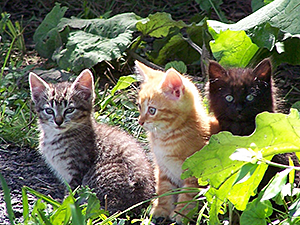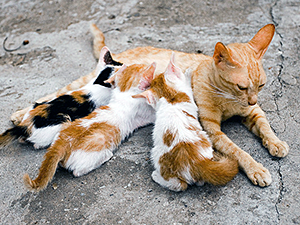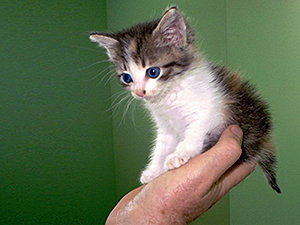
Taming, or “socialization,” is needed when kittens have had no positive interaction with humans and are so frightened or aggressive that they cannot be handled at all, or at least not safely. If you want to easily tame feral or undersocialized kittens for adoption, there is a narrow window of opportunity between four and eight weeks of age.
Kittens under two months old usually can be socialized very quickly using food as an incentive to befriend humans because they have not yet developed the strong “fight or flight” instinct of older kittens. Often within a day or weekend of work they are comfortable being handled by humans and will quickly adjust to the atmosphere in the cage setting of a busy store or adoption facility. After two months of age, the combination of age, gender, genetics, and life experience of the cat will determine whether a cat might be easily tamed for adoption or will need a prolonged period of work to be at all comfortable around humans. Predictions of time needed to tame an older kitten or cat are hard to make when all these variables come into play.
Why is it so easy to tame kittens under two months of age?
The optimal time to quickly tame feral kittens is between four and eight weeks, their natural weaning period. There are many biological reasons that make kittens emotionally predisposed to accepting humans so readily at this age. During this time, kittens begin the transition from complete dependence on their mother to complete independence. Some have likened the impact of this stage to the transformation of a caterpillar to a butterfly. Nature converges many factors to make the readiness to learn a completely new way of life from mom very strong at this point.

Nature encourages this process by making moms increasingly intolerant of nursing, thereby increasing hunger in the kittens and adding a strong incentive to learn to hunt. While nursing, moms steadily lose weight, using up their body stores. Nature needs her to stop nursing and caring for the current litter to regain her condition to be ready for the next breeding cycle. Along with these hormonal changes in mom, the growing teeth of the kittens and their sharp claws kneading her belly further inspire mom to teach them to hunt rather than to continue nursing. All of these influences come together for a very efficient transition to independence.
To further impress the importance of this timing, science has shown that while kittens are very ready to learn and change habits between four and eight weeks, they are also very reluctant to give up any impressions formed at this age. This period is when nature has biologically predisposed kittens to learn and absorb basic life lessons at warp speed. Whichever teacher gets there first has the strongest influence on their opinions for a lifetime. It is important to create a positive association with humans before they have learned otherwise. Once a fear of humans is ingrained, it is very hard to change their young minds.

Start the taming early, be consistent, and get it done as young as possible! Otherwise, be prepared to be very patient and forget any timeline. It can be done, but there are no guarantees as to how long it might take to gain an older kitten or cat’s trust. While cats are very adaptable and can change their opinions over time, nature has stacked the deck against any “Johnny-come-lately” lessons in the joys of a life with humans.
For info about taming older feral kittens, see the three-part video, Tough Love: Socializing Feral Kittens, or consult Urban Cat League’s Taming Ferals! page.
 About the Author
About the Author
Mike Phillips, LVT, is the Community Outreach Coordinator for the NYC Feral Cat Initiative of the Mayor’s Alliance for NYC’s Animals. Mike prepares presentations for the general public, trappers, and professional audiences; heads up our community outreach efforts; and responds to requests for information about taming feral kittens, trapping assistance, and feral-friendly spay/neuter resources. Mike is a co-founder of Urban Cat League, a former president of Neighborhood Cats, and has worked as the Veterinary Technician Supervisor at the ASPCA Adoption Center in New York City and worked in the ASPCA Animal Hospital’s ICU and on the ASPCA’s Mobile Spay/Neuter Clinic. His tried-and-true taming techniques are featured in Tough Love: Socializing Feral Kittens, a video used by animal shelters around the world. Mike’s “day job” that pays for all that kitty litter is working for New York City Opera, where he’s a resident stage director.

